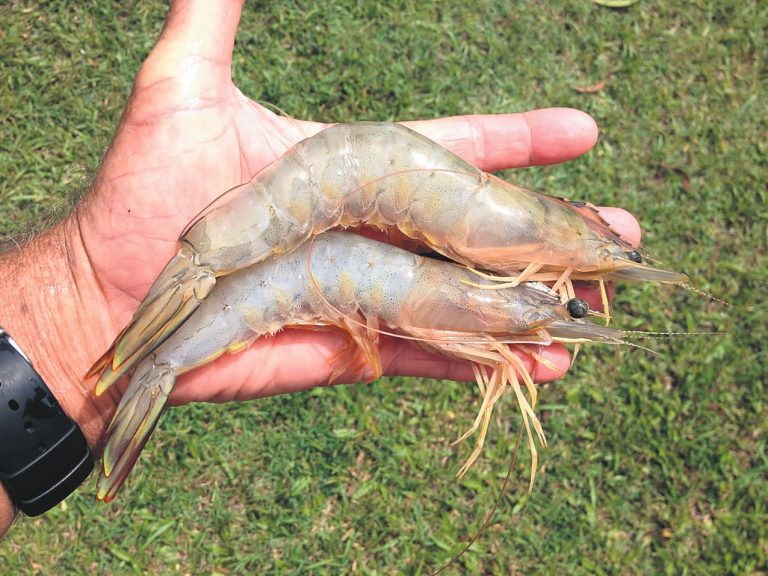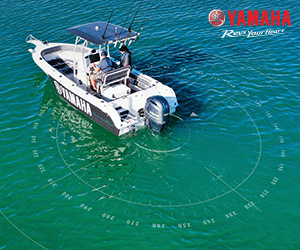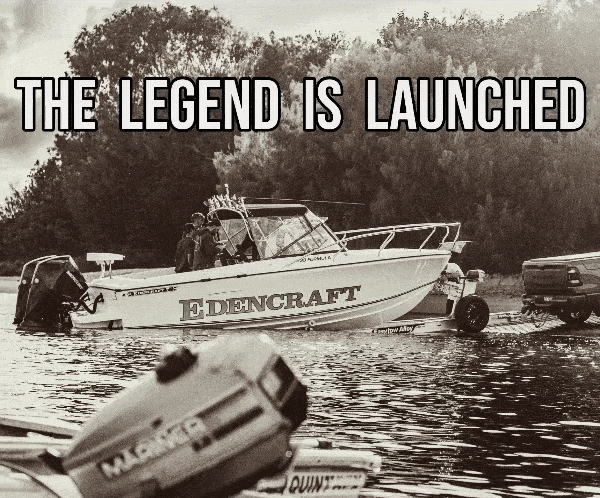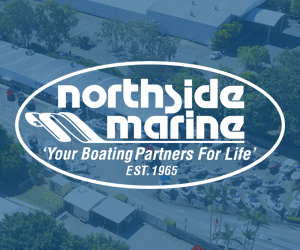Moreton Bay’s – “Banana Republic”
By Bill Bowtell
On location
Famed US short story writer O. Henry would frown and scowl at the mere thought of referring to Brisbane’s Moreton Bay, as a “Banana Republic”. For it was Henry who first coined the term, way back in 1904, to describe (amongst other things) a country which is politically unstable and which has a single-source economy based on primary production.
“Well, in defence of the title, that could be argued!”
Each year Moreton Bay turns it on with a massive recruitment and production of banana prawns, almost to the exclusion of all else. It then follows that instability arises between the factions competing for the resource. And these are several.
The opportunity to first experience the “banana prawn run” came back in late March of this year. Reports being posted in local bayside papers indicated good catches of medium sized banana prawns (14-17cms) being taken right throughout the creeks and rivers flowing into Moreton Bay from the Logan River in the south to the Caboolture River in the north. These prawns were beginning to school, holding up in the deep holes (3-9 metres), before their annual run to the bay proper. I did a run down to the mouth of the Logan River from the Victoria Point boat ramp, just for a look-see. For a boy from the bush it was an eye-opener.
The local “hot-spot” at the Logan River is a place called, “The Power Lines”, named for obvious reasons – a high voltage power line crosses there! The water depth varies between 4-11 metres and the prawns gather along the edge of the main drop-off and out into the middle of the channel. There are readily identifiable on your sounder.
On this particular day there would have been forty boats in the area, in a patch of about two hundred metres by one hundred metres in size. Most boats had at least two occupants. All were catching prawns – green bananas, of a medium size. I had a few shots with my old cast net and whilst I nailed about a dozen prawns in half a dozen casts, I quickly realised that I was completely under-gunned. This was a whole new ball-game and I had a lot to learn. That opportunity soon came.
My good mate Maurice Lonzar is a keen prawner and his wife Maria is a wonderful cook. Prawns feature regularly on their menu when the seasonal run is on. Maurice lives on the northern shores of Moreton Bay at Scarborough and has his finger on the pulse when the prawns begin to school in the rivers and eventually move out into the bay. Especially when they appear out the front of Nudgee Beach just north of the mouth of the Brisbane River. The prawns appeared and I was offered a trip. What an experience!
The time
I was told we had to be in “position” off Nudgee Beach just before sunrise. This was due to the fact that bananas will school and “rise”, or “boil”, at the surface generally at first light just before sunrise. If they are “boiled”, then it is possible, with a perfect cast (and the correct type of net), to score a “bag” – (that full pocket at the top of the net). Two “bags” and that is your 10 litre personal bag limit. In the majority of circumstances it is not that easy. But it has been done!
We left the boat ramp at Shorncliffe’s Cabbage Tree Creek at 4.30am and made the relatively short run to Nudgee Beach. We were not alone. Boats were coming from all directions – the Brisbane River, Nudgee Beach and from across Bramble Bay at Clontaff. It was comparable to the “Charge of the Light Brigade”. The word was well and truly out. On the way across I got whacked in the head, and then the back, by two prawns. We had passed through a school. Two prawns and not a net thrown!
The nets
These were cast-nets, specially designed for prawning in waters of 3-9 metres in depth. They were made of hand woven monofilament with a drop of the maximum allowable 3.7 metres from point of attachment of the casting cord to the net lead line. The lead line on the net used by Maurice was a continuous lead chain weighing 8kgs, and on the net that I was using there were intermittent lead weights on the bottom cord line. It weighed 7kgs. There were no bottom line pockets.
The pocket design within the nets was a “top-pocket”, which occupies about 700mm of the top of the net. It is closed off at the top during the cast, which then opens the bottom of the pocket inside the net. When the net is cast and spreads, the entrapped prawns shoot to the top of the net and are caught up inside the “pocket”. This pocket then closes as the net is drawn back to the caster. A simple “slide” on the main casting chord opens the top of the pocket to empty the catch of prawns. The locals make it look easy – don’t be fooled!
Maurice was sympathetic to my cause. He was also sympathetic to my catch of 6 prawns in as many casts to his 60 odd. And I taught him how to throw a net all those years ago at Karumba!
The cast
I am an “off-the-shoulder” caster, and from a stable surface with my trusty old net of 4kgs I can pit myself against the best, but 7-8kgs with a minimum time to prepare a shot – it takes practice. And the style has to be right. You don’t cast an 8kg net – you throw it! Just watch the local Vietnamese prawners; they are expert exponents and a joy to watch. And so is Maurice. I am learning and can now hold my own, but there has been a lot of practice sessions. And there had to be!
It became very obvious in that first session that prawns move quick when they are travelling. And whilst they might burst out of the water in front, or side, of you, they will not necessarily be in that spot by the time the boat stops and you get to your feet, load the net and throw away. Most of the locals work in tandem with one driving and the other loaded with net ready to cast. Then there are those whose casting style (wrist-grab), allows them to have the net ready and drive at the same time. Then, when the prawns are located, they stand and just cast away. For those regulars (and some have been at it for more than 30 years) it is easy and they maximize their opportunities with more productive casts.
For the newcomer to prawning, being able to identify a school of prawns, or even individual prawns located on the bottom, from jellyfish, fish, plankton and general sea-life can be a daunting task. It is further complicated when different sounders display different outputs of intensity.
I own a Hummingbird 788ciHD. It will show prawns as a broken “bubble” of red with a yellow centre, if they are schooled. If the prawns are located near, or on the bottom, they appear as singular “streaks”, like little sticks stuck in the mud. These streaks are black with red centres and are usually big prawns in the 20-25cm range.
The run of banana prawns in the bay usually ends around the start of May when the sou’westers kick in. This cools the water and the prawns move. It is fast and furious fun and physically taxing. I estimated that my personal effort throughout April of this year saw me lift the equivalent of 10 tonnes. No! They weren’t prawns (but I did alright) – it was lifting that bloody net!
Footnote
- Moreton Bay has Marine Park Zoning status including “Green Zones”. Visitors must acquaint themselves with these areas.
- The maximum length of cast net is 3.7 metres from point of attachment of casting chord to lead line.
- The “in possession” bag limit for prawns is 10 liters per person.
- All prawns in possession must be in “head-on” condition unless being immediately consumed.
DSC_0095: Atypical Moreton Bay prawn cast-net showing bottom line, casting chord and top-pocket. The net measures 3.7m drop.
DSC_0098: The orange “slide” on the casting chord opens and shuts the top-pocket to either release the prawns into the bin or to close the pocket to throw the net.
DSC_0096: The top-pocket of the net. Note the internal draw-strings which holds the pocket in place inside the net proper.
DSC_0099: Pushed all the way down the casting chord, the orange slide closes the top-pocket in preparation for throwing.
IMG_0119: A perfect morning’s prawing on Moreton Bay produced 20kgs of first class banana prawns.
IMG_0120: The result of my first ever solo trip chasing MB’s banana prawns – 10kgs of “Banana Republic’s” primary production.
IMG_0121: Medium to large bananas. These prawns went between 19 and 24cms.
IMG_ 0122: Lorraine holds a genuine 26cm prawn taken wide of Nudgee Beach in Moreton Bay.
IMG_0123: What all the effort is for! A succulent stir-fried meal of prawns, noodles and fresh veges.
IMG_0124: Half a dozen of the best. The biggest at 29cms. The energy drink was needed.
IMG_0125: Eight prawns for 510gm – a quarter-of-a-bag of prawns around this size really make the net kick!
IMG_0126: Two of the biggest prawns of Bill’s last trip just before Anzac Day – both nudging the 28cm mark.





